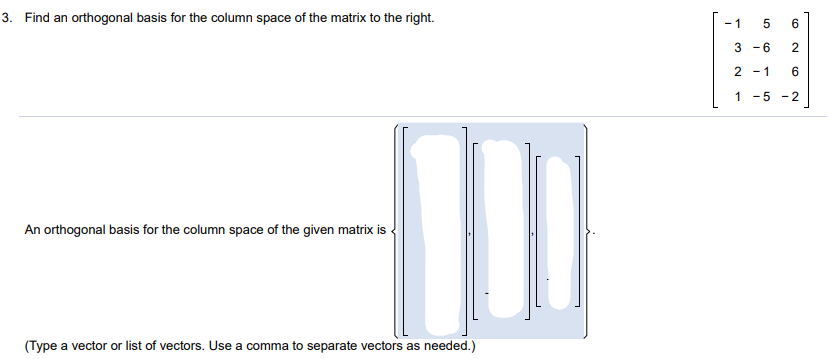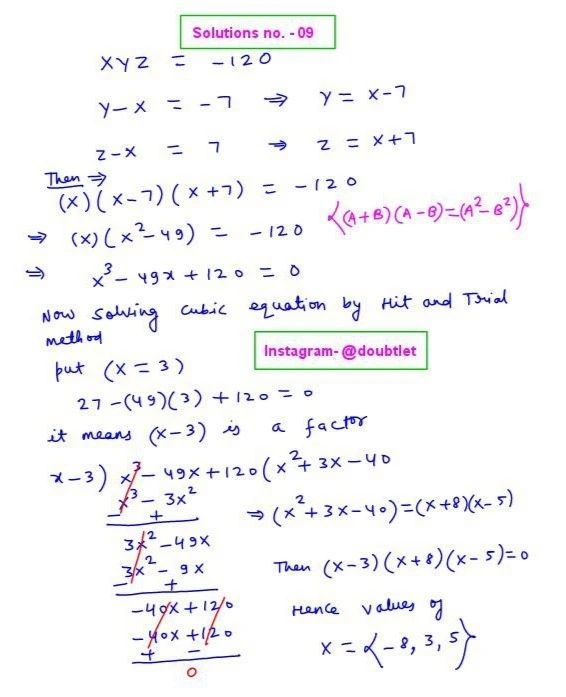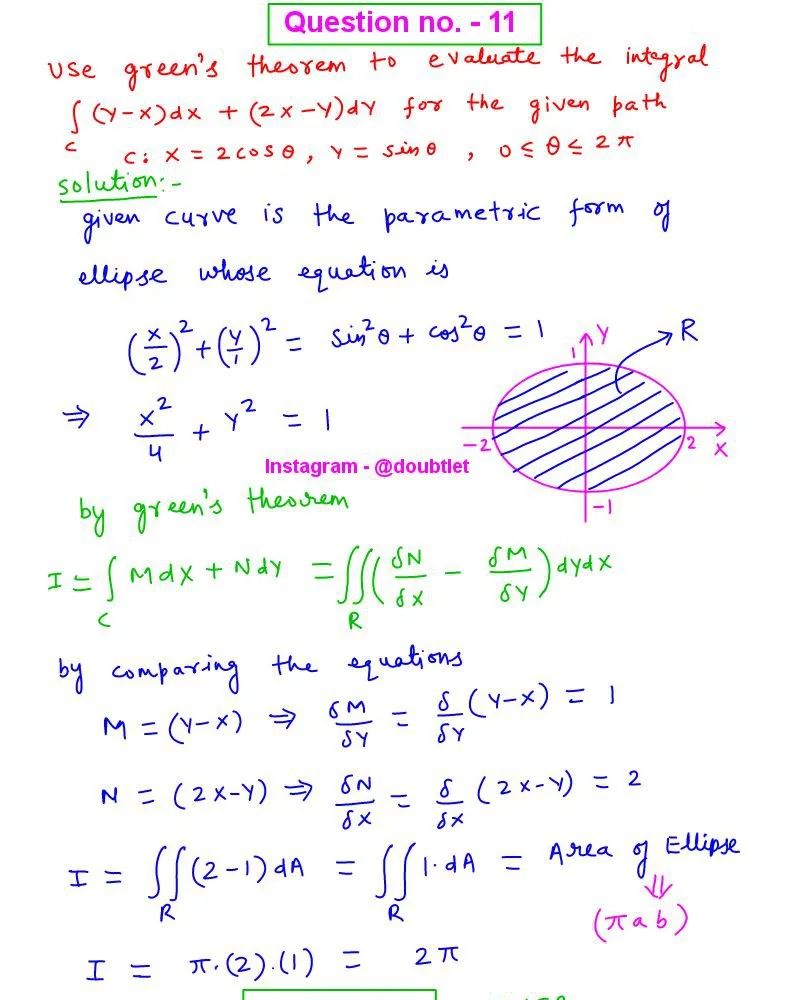Neetesh Kumar | October 20, 2024
Linear Algebra Homework Help
This is the solution to Math2B Course: Linear Algebra Assignment: Ch6 Section 4 Question Number 3 Contact me if you need help with Homework, Assignments, Tutoring Sessions, or Exams for STEM subjects. Testimonials or Vouches from here of the previous works I have done.
Get Linear Algebra Homework Help
Step-by-step solution:
Step 1 : Let v 1 \mathbf{v}_1 v 1 v 2 \mathbf{v}_2 v 2 v 3 \mathbf{v}_3 v 3 Gram-Schmidt process to these vectors to find an orthogonal basis.
Start with u 1 = v 1 \mathbf{u}_1 = \mathbf{v}_1 u 1 = v 1 u 1 = [ − 1 3 2 1 ] \mathbf{u}_1 = \begin{bmatrix} -1 \\ 3 \\ 2 \\ 1 \end{bmatrix} u 1 = − 1 3 2 1
Step 2 : Compute the projection of v 2 \mathbf{v}_2 v 2 u 1 \mathbf{u}_1 u 1 proj u 1 v 2 = v 2 ⋅ u 1 u 1 ⋅ u 1 u 1 \text{proj}_{\mathbf{u}_1} \mathbf{v}_2 = \frac{\mathbf{v}_2 \cdot \mathbf{u}_1}{\mathbf{u}_1 \cdot \mathbf{u}_1} \mathbf{u}_1 proj u 1 v 2 = u 1 ⋅ u 1 v 2 ⋅ u 1 u 1
First, compute the dot products: v 2 ⋅ u 1 = [ 5 − 6 − 1 − 5 ] ⋅ [ − 1 3 2 1 ] = 5 ( − 1 ) + ( − 6 ) ( 3 ) + ( − 1 ) ( 2 ) + ( − 5 ) ( 1 ) = − 5 − 18 − 2 − 5 = − 30 \mathbf{v}_2 \cdot \mathbf{u}_1 = \begin{bmatrix} 5 \\ -6 \\ -1 \\ -5 \end{bmatrix} \cdot \begin{bmatrix} -1 \\ 3 \\ 2 \\ 1 \end{bmatrix} = 5(-1) + (-6)(3) + (-1)(2) + (-5)(1) = -5 - 18 - 2 - 5 = -30 v 2 ⋅ u 1 = 5 − 6 − 1 − 5 ⋅ − 1 3 2 1 = 5 ( − 1 ) + ( − 6 ) ( 3 ) + ( − 1 ) ( 2 ) + ( − 5 ) ( 1 ) = − 5 − 18 − 2 − 5 = − 30
u 1 ⋅ u 1 = ( − 1 ) 2 + 3 2 + 2 2 + 1 2 = 1 + 9 + 4 + 1 = 15 \mathbf{u}_1 \cdot \mathbf{u}_1 = (-1)^2 + 3^2 + 2^2 + 1^2 = 1 + 9 + 4 + 1 = 15 u 1 ⋅ u 1 = ( − 1 ) 2 + 3 2 + 2 2 + 1 2 = 1 + 9 + 4 + 1 = 15
So, the projection is: proj u 1 v 2 = − 30 15 u 1 = − 2 [ − 1 3 2 1 ] = [ 2 − 6 − 4 − 2 ] \text{proj}_{\mathbf{u}_1} \mathbf{v}_2 = \frac{-30}{15} \mathbf{u}_1 = -2 \begin{bmatrix} -1 \\ 3 \\ 2 \\ 1 \end{bmatrix} = \begin{bmatrix} 2 \\ -6 \\ -4 \\ -2 \end{bmatrix} proj u 1 v 2 = 15 − 30 u 1 = − 2 − 1 3 2 1 = 2 − 6 − 4 − 2
Now, subtract this projection from v 2 \mathbf{v}_2 v 2 u 2 \mathbf{u}_2 u 2 u 2 = v 2 − proj u 1 v 2 = [ 5 − 6 − 1 − 5 ] − [ 2 − 6 − 4 − 2 ] = [ 3 0 3 − 3 ] \mathbf{u}_2 = \mathbf{v}_2 - \text{proj}_{\mathbf{u}_1} \mathbf{v}_2 = \begin{bmatrix} 5 \\ -6 \\ -1 \\ -5 \end{bmatrix} - \begin{bmatrix} 2 \\ -6 \\ -4 \\ -2 \end{bmatrix} = \begin{bmatrix} 3 \\ 0 \\ 3 \\ -3 \end{bmatrix} u 2 = v 2 − proj u 1 v 2 = 5 − 6 − 1 − 5 − 2 − 6 − 4 − 2 = 3 0 3 − 3
Step 3 : Compute the projection of v 3 \mathbf{v}_3 v 3 u 1 \mathbf{u}_1 u 1 u 2 \mathbf{u}_2 u 2
First, the projection onto u 1 \mathbf{u}_1 u 1 proj u 1 v 3 = v 3 ⋅ u 1 u 1 ⋅ u 1 u 1 \text{proj}_{\mathbf{u}_1} \mathbf{v}_3 = \frac{\mathbf{v}_3 \cdot \mathbf{u}_1}{\mathbf{u}_1 \cdot \mathbf{u}_1} \mathbf{u}_1 proj u 1 v 3 = u 1 ⋅ u 1 v 3 ⋅ u 1 u 1
Dot products: v 3 ⋅ u 1 = [ 6 2 6 − 2 ] ⋅ [ − 1 3 2 1 ] = 6 ( − 1 ) + 2 ( 3 ) + 6 ( 2 ) + ( − 2 ) ( 1 ) = − 6 + 6 + 12 − 2 = 10 \mathbf{v}_3 \cdot \mathbf{u}_1 = \begin{bmatrix} 6 \\ 2 \\ 6 \\ -2 \end{bmatrix} \cdot \begin{bmatrix} -1 \\ 3 \\ 2 \\ 1 \end{bmatrix} = 6(-1) + 2(3) + 6(2) + (-2)(1) = -6 + 6 + 12 - 2 = 10 v 3 ⋅ u 1 = 6 2 6 − 2 ⋅ − 1 3 2 1 = 6 ( − 1 ) + 2 ( 3 ) + 6 ( 2 ) + ( − 2 ) ( 1 ) = − 6 + 6 + 12 − 2 = 10
Thus, proj u 1 v 3 = 10 15 u 1 = 2 3 [ − 1 3 2 1 ] = [ − 2 3 2 4 3 2 3 ] \text{proj}_{\mathbf{u}_1} \mathbf{v}_3 = \frac{10}{15} \mathbf{u}_1 = \frac{2}{3} \begin{bmatrix} -1 \\ 3 \\ 2 \\ 1 \end{bmatrix} = \begin{bmatrix} -\frac{2}{3} \\ 2 \\ \frac{4}{3} \\ \frac{2}{3} \end{bmatrix} proj u 1 v 3 = 15 10 u 1 = 3 2 − 1 3 2 1 = − 3 2 2 3 4 3 2
Next, subtract this from v 3 \mathbf{v}_3 v 3 v 3 − proj u 1 v 3 = [ 6 2 6 − 2 ] − [ − 2 3 2 4 3 2 3 ] = [ 1 0 0 1 ] \mathbf{v}_3 - \text{proj}_{\mathbf{u}_1} \mathbf{v}_3 = \begin{bmatrix} 6 \\ 2 \\ 6 \\ -2 \end{bmatrix} - \begin{bmatrix} -\frac{2}{3} \\ 2 \\ \frac{4}{3} \\ \frac{2}{3} \end{bmatrix} = \begin{bmatrix} 1 \\ 0 \\ 0 \\ 1 \end{bmatrix} v 3 − proj u 1 v 3 = 6 2 6 − 2 − − 3 2 2 3 4 3 2 = 1 0 0 1
Thus, the orthogonal basis for the column space is: u 1 = [ − 1 15 3 15 2 15 1 15 ] , u 2 = [ 1 3 0 1 3 − 1 3 ] , u 3 = [ 1 2 0 0 1 2 ] \mathbf{u}_1 = \begin{bmatrix} -\frac{1}{\sqrt{15}} \\ \frac{3}{\sqrt{15}} \\ \frac{2}{\sqrt{15}} \\ \frac{1}{\sqrt{15}} \end{bmatrix}, \quad \mathbf{u}_2 = \begin{bmatrix} \frac{1}{\sqrt{3}} \\ 0 \\ \frac{1}{\sqrt{3}} \\ -\frac{1}{\sqrt{3}} \end{bmatrix}, \quad \mathbf{u}_3 = \begin{bmatrix} \frac{1}{\sqrt{2}} \\ 0 \\ 0 \\ \frac{1}{\sqrt{2}} \end{bmatrix} u 1 = − 15 1 15 3 15 2 15 1 , u 2 = 3 1 0 3 1 − 3 1 , u 3 = 2 1 0 0 2 1
Please comment below if you find any error in this solution.
If this solution helps, then please share this with your friends.
Please subscribe to my
Youtube channel for video solutions to similar questions.
Keep Smiling :-)















Leave a comment